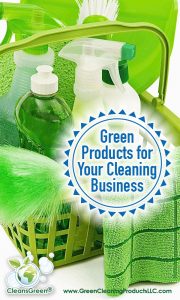How to Buy Green Products for Your Cleaning Business
If you would like to learn more about having a cleaning business please check out, How To Start A Cleaning Business and How To Market Your Green Cleaning Business.

What products do you use for your cleaning business? Are they green? If not, do you need to go green? These are all important questions. There are reasons to use green cleaning products and supplies that are different from the obvious one of protecting out planet. It is good for business and it is safer for you and your team.
What is Green Cleaning
Green cleaning refers to using cleaning methods and products with environmentally friendly ingredients and developing and using methods to clean which are specifically designed to preserve both human health and environmental quality.Eco friendly cleaning should be a holistic approach that incorporates human health and environmental impact centric solutions. This involves more than the chemicals used to clean, but also involves the
- supplies, equipment, tools,
- processes and procedures, and
- commitment to continuous improvement.
Why Is It Important to Use Green Cleaning Products
There are the 6 Reasons Why Green Cleaning Products are So Vital.Moreover, we are exposed to residue from cleaning products whether as a cleaner (janitor, custodians, maid, housecleaner, or domestic helper) or an occupant of the building that has been cleaned. The cleaning industry employs about 2.8 million janitors. In addition to the professional janitorial staff, who are using cleaning products daily, many other building occupants perform light cleaning on a routine or occasional basis, e.g. dusting, wiping off desks and counters, etc. All building occupants are also potentially exposed to the hazards and volatile components of cleaning products.
Of the estimated 85,000 chemicals in the U.S. marketplace that the average person is exposed to in their daily life, sadly, only a small fraction of them have ever been tested for their chronic impacts to human health. While Europe has banned 1,100 chemicals from use in products, the US has banned fewer than 10. This concern increases when it takes as little as 26 seconds for a toxic chemical to get into our body. These chemicals enter into our body through inhalation, ingestion and/or absorption.
Volatile organic compounds (VOC) are common in cleaning products. As well as acute health effects, VOC’s affect indoor air quality leading to long term consequences while also contributing to smog formation in outdoor air.
Additionally most cleaning products sport a “clean and fresh” smell. Many consumers like the way their cleaning products smell, but they may not know that fragrance can contain highly toxic substances. Although this sounds benign, in fact the fragrances can be the most toxic aspect of the cleaning product formulation. Fragrances are only a smidgen of the total ingredients, but they have been found to be more toxic than other ingredient … even in minute amounts.
Furthermore, cleaning chemicals have been found in those dust bunnies lurking around in the corners. The Safer Products Project (2005) found household dust have shown high levels of volatile organic compounds (VOCs), asthmagens and other toxic chemicals.
There is a real toll on human health from cleaning, data from Washington State show that about six percent of janitors experience a job-related injury from chemical exposure related to cleaning products every year.
The damage extends to the environment resulting from the use of cleaning products through evaporation of volatile components as well as that rinsed down the drain of residual product from cleaned surfaces, mops, and sponges.
Like the hazards experienced by exposed humans, there is also acute and chronic toxicity to aquatic species in waters receiving inadequately treated wastes. For example, if an ingredient is harmful to humans (such as alkylphenol ethoxylates, a common surfactant ingredient in cleaners and a known endocrine disrupter) the same adverse reproductive effects can be seen in wildlife exposed to polluted waters.
Benefits of Buying Green Cleaning Products
Good news! There is an option and a way to minimize the danger, which is to select and source only green cleaning products. This means to choose less hazardous products that have positive environmental attributes. In researching options, seek and select products that demonstrate:- fragrance free,
- biodegradability,
- ingredients that are made from renewable resources,
- safe (noncorrosive & nonreactive)
- low toxicity,
- low volatile organic compound (VOC) content,
- reduced packaging, and
- low life cycle energy use.
Even better, procuring less hazardous cleaners may reduce costs when it comes time to properly dispose of any leftover cleaner.
This goes a long way in reducing exposure and minimize harmful impacts to cleaners and building occupants, improving indoor air quality, and decreasing water and ambient air pollution while also ensuring the effectiveness of cleaning.
How to Buy Green Cleaning Products
Greenwashing is common in the cleaning products industry. As such be especially careful in interpreting vague or generic claims such as “environmentally friendly,” “eco safe,” and “green”.The easiest way to ensure you are not being greenwashed is to only purchase and use cleaners that carry one or more of the third party certifications available for cleaning products (i.e., Green Seal, EcoLogo, and/or DfE / Safer Choice. These certifications enable you to have confidence that the cleaners are nontoxic with a low impact on the environment.
There is no need on becoming a chemist yourself to interpret the ingredient list! It is also valuable to note that part of the certification criteria is efficacy of the cleaner.
This you can be confident that the cleaner works for the designated application.

No comments:
Post a Comment